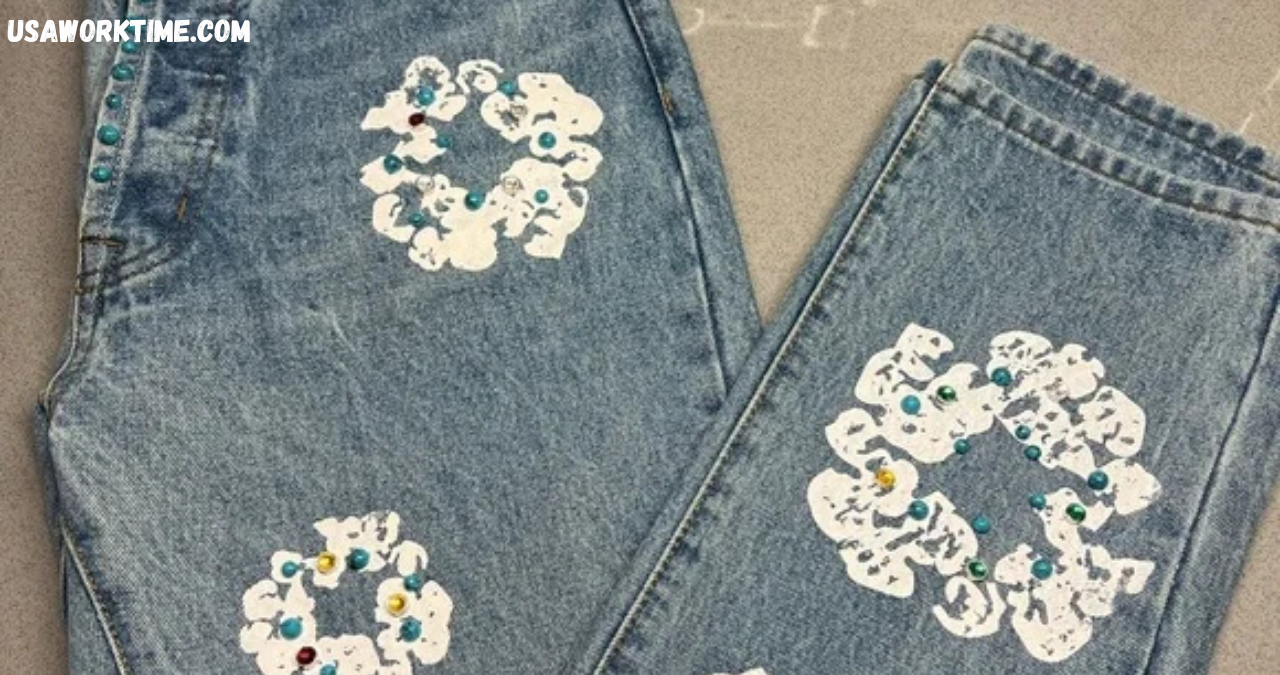Introduction
In the ever-evolving world of fashion, where trends come and go, Denim Tears Jeans stands as a powerful voice of resistance, heritage, and cultural commentary. More than just a brand, Denim Tears Jeans has managed to stitch the African American narrative into the very seams of streetwear. Founded by Tremaine Emory, the label has garnered respect not only for its unique design aesthetics but for its dedication to storytelling through garments. In an age where authenticity is rare, Denim Tears jeans tell stories of history, struggle, and triumph.
From high fashion runways to the sidewalks of New York and LA, Denim Tears has captured the imagination of those who see fashion as more than just apparel—a reflection of identity and history. This article explores the roots of the brand, the symbolism within its designs, its explosive popularity, and how wearers can style Denim Tears Jeans jeans with intention. Whether you’re a streetwear aficionado or a cultural history enthusiast, the journey of Denim Tears offers a masterclass in how fashion can intersect with activism and art.
The Origins of Denim Tears A Brand Rooted in Resistance
Tremaine Emory, widely known in creative circles as “Denim Tears Jeans,” has always used fashion as a vessel for cultural dialogue. Before launching his own brand, Emory worked closely with notable icons like Kanye West, Frank Ocean, and Virgil Abloh, gaining insights into creative direction and artistic innovation. These collaborations gave him the tools and visibility to build something deeply personal and socially impactful. Emory’s vision wasn’t just about launching another trendy brand—it was about using fashion as a lens to examine America’s racial history and bring hidden narratives to light.
Raised with a profound understanding of African American culture and systemic injustices, Emory envisioned Denim Tears Jeans as an artistic reaction to centuries of oppression. He wanted to confront consumers with the untold stories of African American resilience. Through his designs, he channels generations of struggle, turning every thread into a form of protest. This depth of purpose has set Denim Tears apart in an industry often criticized for cultural appropriation and superficiality.
The Birth of Denim Tears in 2019
Denim Tears Jeans made its debut in 2019 during Black History Month, a deliberate and meaningful launch. The first collection featured denim pieces emblazoned with cotton wreath motifs, a stark reminder of the painful legacy of slavery in America. The cotton symbol was not chosen arbitrarily; it represented the crop that millions of enslaved Africans were forced to harvest, the very backbone of America’s early economic success.
By imprinting these symbols on Levi’s denim—an iconic fabric of American workwear—Emory reclaimed a space in fashion long dominated by Eurocentric narratives. The message was clear: the foundation of American fashion, like much of the nation’s prosperity, was built on the backs of Black labor. Emory’s launch was not just a commercial endeavor; it was a political statement that forced the industry to reckon with its past.
Collaborations that Cemented the Brand’s Status
Following its impactful debut, Denim Tears Jeans quickly entered the spotlight with collaborations that highlighted its message and extended its reach. Teaming up with brands like Converse, Supreme, and Dior, Emory brought the story of African American perseverance to global fashion stages. One of the most memorable collaborations was with Levi’s itself, creating a full-circle moment that honored the fabric’s roots while recontextualizing it through a Black historical lens.
These partnerships weren’t merely about commercial expansion; they were about amplifying voices and embedding cultural meaning into high fashion. Unlike other brands that dilute their messages when entering mainstream collaborations, Denim Tears Jeans stayed true to its ethos. Each partnership reinforced the brand’s original intent—to honor Black identity, provoke dialogue, and challenge industry norms.
Symbolism Woven into the Fabric The Message Behind the Design
At the heart of Denim Tears Jeans’ identity lies the cotton wreath motif. This symbol, prominently displayed on its signature jeans, is a visual eulogy to the enslaved African Americans who toiled in cotton fields. It’s both haunting and beautiful—a deliberate juxtaposition meant to awaken the viewer. Unlike generic design elements, the wreath serves as an emblem of remembrance and resilience.
Emory chose the wreath shape to evoke funerary symbolism—a tribute to the lives lost and labor extracted under the yoke of slavery. The motif forces the fashion world to confront its complicity in historical erasure and exploitation. Instead of shying away from painful truths, Denim Tears Jeans embraces them, using art to transform suffering into strength. It’s a reminder that fashion can be more than fabric; it can be a tool for remembrance.
Denim as a Medium of Protest
Denim has long been a fabric associated with rebellion. From miners to civil rights activists, it has been the uniform of the working class and the outspoken. Emory taps into this legacy, transforming Levi’s denim into canvases of political expression. His use of denim is intentional—it speaks to the roots of American labor while redefining who gets to wear and interpret it.
Every pair of Denim Tears Jeans jeans becomes a manifesto. The rugged texture of denim contrasts with the soft imagery of cotton, creating tension that reflects the contradictions of American history. The wearer becomes a participant in a broader conversation, walking through the world in garments that challenge passersby to reflect. In Emory’s world, wearing jeans becomes a radical act.
The Visual Language of Streetwear Activism
Streetwear has always been a language of the people, and Denim Tears Jeans uses that language to tell stories that matter. Emory doesn’t just design clothes; he curates experiences. Through visual storytelling—from lookbooks to fashion shows—he amplifies voices often silenced in traditional fashion narratives. The imagery is often stark, unfiltered, and emotionally charged, compelling the viewer to reckon with their own place in history.
By blending fine art with streetwear, Denim Tears challenges the fashion world to think beyond profit margins and aesthetics. The brand has influenced a new wave of designers who prioritize cultural authenticity and social justice. It’s not just about looking good; it’s about wearing your values on your sleeve—literally.
Popularity and Influence From Subculture to Mainstream Fashion
Denim Tears has become a staple among influential celebrities who understand the brand’s message and want to amplify it. Stars like ASAP Rocky, Rihanna, and Tyler, The Creator have been spotted wearing Denim Tears jeans, turning them into symbols of cultural awareness and fashion-forward thinking. These endorsements have not only increased visibility but have helped position the brand as a voice of modern-day activism.
Through these high-profile appearances, Denim Tears Jeans has transcended niche streetwear circles and entered mainstream consciousness. It has become a symbol of intellectual fashion—clothing worn not just for style, but for substance. As these artists and influencers share their support for Emory’s work, they spark conversations about race, history, and accountability, proving that fashion can indeed fuel social change.
Streetwear Meets High Fashion

Denim Tears Jeans walks a fine line between underground authenticity and high fashion prestige. Its collaborations with Dior and Supreme have positioned the brand alongside luxury labels without compromising its message. Emory’s ability to maintain cultural integrity while engaging with mainstream fashion giants is a testament to his vision.
This fusion of streetwear and high fashion isn’t just about style—it’s about access and influence. Emory ensures that the stories of Black America are not relegated to the margins but are instead celebrated in the most prestigious fashion arenas. Denim Tears proves that activism and elegance are not mutually exclusive.
Limited Drops and Hype Culture
Like many streetwear brands, Denim Tears Jeans thrives on limited releases that create buzz and demand. Each drop is an event, sparking online discussions and resale frenzies. However, unlike typical hype-based fashion brands, Denim Tears uses this model to maintain focus and intention, rather than to simply drive up prices.
This exclusivity has a double-edged effect: while it elevates the brand’s status, it also raises questions about accessibility. Can a brand built on cultural remembrance remain exclusive without alienating the very community it seeks to honor? Emory acknowledges this tension, often balancing hype culture with thoughtful community engagement and education.
Styling Denim Tears Jeans Cultural Awareness Meets Contemporary Fashion
Despite their symbolic weight, Denim Tears Jeans jeans are incredibly wearable. They pair effortlessly with basic tees, hoodies, and sneakers, allowing the design to take center stage. For those new to the brand, a minimalist approach works best—let the jeans speak for themselves.
The denim’s quality and fit make them versatile enough for casual settings while still drawing attention. Whether you’re walking through Brooklyn or attending an art opening in LA, these jeans carry presence. Styling them with neutral tones ensures the motifs remain the focal point, honoring their deeper message.
Streetwear Looks with Meaning
For seasoned streetwear enthusiasts, Denim Tears Jeans jeans serve as the cornerstone of bolder outfits. Think oversized jackets, graphic tees with activist slogans, and statement sneakers. The key is cohesion—each piece should complement the jeans’ narrative rather than distract from it.
Layering with other socially-conscious brands like Telfar or Pyer Moss can amplify your look while showing alignment with fashion rooted in justice. Accessorize with meaningful pieces like heritage jewelry or cultural fabrics to create an ensemble that is both stylish and significant.
Fashion as Protest Wearing with Purpose
Wearing Denim Tears jeans isn’t just a fashion choice—it’s a responsibility. Understanding the story behind the design is essential. Emory’s work invites the wearer to participate in activism through clothing, turning every outfit into a form of protest.
Before donning these jeans, consider educating yourself about the history they represent. Engage in conversations sparked by your wardrobe. Fashion becomes transformative when worn with intention, and Denim Tears Jeans offers that unique opportunity to wear history, remembrance, and resistance.
Conclusion
Denim Tears Jeans is more than a fashion brand; it’s a cultural archive woven with care, consciousness, and courage. Through Tremaine Emory’s visionary leadership, the brand has transformed jeans into a medium of protest, pride, and progress. By honoring African American history and confronting systemic injustices, Denim Tears Jeans invites the world to wear not just denim, but truth.In an industry saturated with fleeting trends, Denim Tears offers permanence—a reminder that fashion can be powerful, personal, and politically charged. As long as stories need telling and history demands honoring, Denim Tears jeans will remain more than a trend; they will be a movement.
You May Also Read: https://usaworktime.com/nano-brows-near-me/










